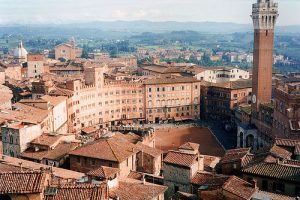
Tuscany is the cradle of the Italian culture, no doubt. For centuries this area has welcomed artists from all over the world, perfect setting for inspiration. Many monuments in Italy are usually closed to the public, sometimes for restauration, sometimes because they are private property and sometimes just because the government cannot afford to keep them open.
Likely, nowadays, more and more often, many of this unaccessible monuments get opened to the public for special occasions, like in this case. Read this very interesting post by Alexandra Korey, a Canadian art history professor turned blogger.
“The Palazzo Chigi Saracini in Siena, seat of the Musical Academy of the same name, contains the collections of Galgano Saracini that he acquired in the late 18th century. This includes works of 13th-century Sienese painting as well as ceramics, bronze statuettes, furniture and much more in a sumptous interior.
Normally closed to the public, the Palazzo is open for guided visits over the winter holidays.
The palazzo was begun in the 12th century by the noble family Marescotti; of this building phase you can see the tower and their crest on the facade above the trilobe windows. Taken over by the Piccolomini family in the 15th century, it was given a new Renaissance interior. Then it was again renovated in 1770 by Marcantonio Saracini, and then it passed into the hands of another important Sienese family, the Chigi.
Galgano Saracini collected about 12,000 pieces that are kept in these rooms. Of the painters represented, recognizable names include Sassetta, Sano di Pietro, Botticelli, Sodoma, Beccafumi… But amongst these Florentine and Sienese paintings are tossed in, eclectically in the style of the 19th century, chinoiserie, porcellian, ivory, gold, carpets, etc.
The guided tours, at a cost of 7 euros, take you to the Gothic rooms and a part of the newer wing. Unfortunately, the museum of historic musical instruments in the same building is not included on the tour, and I’ve been informed that visits are only granted for reasons of study through written request.”